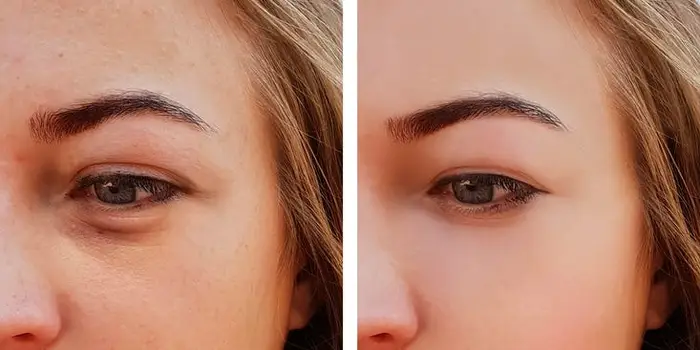What causes puffy eyes and how to get rid of them?
We have all experienced some form of puffiness around the eyes at some point. While there can be a variety of reasons for puffy eyes, including genetics, skin type, and allergies, there are home and professional remedies that can temporarily treat them. To treat them long-term, the underlying cause of the swelling must be addressed first. Together, we will find out by examining what causes puffy eyes and how to get rid of them.
What causes puffy eyes?
Puffy eyes are caused by a variety of reasons. Typically, the swelling you notice around your eyes is caused by excess fluid surrounding the skin tissue, known as edema. This swelling is more noticeable because the skin around the eyes is so thin. There are many factors that can cause swelling, such as:
Allergies, such as hay fever
Sinus infections
Excessive salt intake
Dehydration
Stress
Crying
Lack of sleep
Fatigue
Aging
Inheritance of facial features
These conditions are easily treatable, with some requiring surgery, while others can be fixed with just a few lifestyle changes.
As far as inherited facial features go, puffy eyes seem to run in the family for some people, and there is no real cure unless you choose surgery. As for aging, puffiness is caused by the skin around the eyes, the fatty tissue that lifts and holds the eyelids in place, weakening, which means the skin shifts and the appearance of the eyes changes, creating bags under the eyes.
Why do eyes look puffier in the morning?
Believe it or not, the way you sleep has a big impact on your eyes. If you sleep on your stomach, you’ll find that fluid can fall to the front of your face and settle in the area under your eyes, causing puffiness and dark circles under your eyes. Sleeping on your back and using a silk pillowcase are some of the simplest things you can change that can have a big effect and help combat swelling.
Some people may also notice that because your eyes are closed, you’re not blinking, which is a way of training your eyes by reducing the amount of fluid around them. You’ll notice that over time any swelling will reduce and you’ll blink more often when you wake up.
Is puffy eyes a sign of an underlying health problem?
Puffy eyes aren’t usually a sign of a health problem, but you should see a doctor if you notice any of the following symptoms:
Pain, irritation, and severe swelling around the eyes
Long-term puffy eyes that you’ve never had before
These symptoms can be signs of a serious problem, such as:
Conjunctivitis (also called conjunctivitis)
Ptosis, or drooping eyelids
Dermatitis
Cellulitis
Blepharitis
Thyroid-related eye disease
How to get rid of puffy eyes?
Here are some ways to treat puffy eyes:
Get enough sleep
Getting enough sleep can help reduce puffy eyes. A good nighttime routine is important for your entire body and mind, not just your eyes. Here are some simple steps you can take before bed.
Don’t drink caffeine at least 6 hours before bed
Stop exercising 5 hours before bed
Don’t eat a large meal or sugary snacks 3 hours before bed
Avoid alcohol before bed
Turn off all electronic devices 2 hours before bed and avoid looking at blue screens.
Drink enough water
Puffy eyes can be caused by dehydration. Try to be mindful of your daily water intake and aim to drink eight glasses of water. Drink a large glass in the morning and half a glass before bed to keep your fluids balanced.
Eat more potassium
Potassium can help reduce excess fluid in your body. Potassium is found in foods such as:
Bananas
Beans
Yogurt
Leafy greens
You should also consult your doctor to determine if you are getting the right amount of potassium, as there are a variety of supplements available that you can try, but you must consult your GP first.
Try an eye cream
There are a variety of eye creams available, many of which have effective formulas with active ingredients that can reduce puffiness, such as hyaluronic acid and cucumber. You’ll also find added vitamin C and caffeine to wake up the eye area, reduce inflammation, and firm and brighten the skin. Learn more about how to find the best eye cream in our blog post.
Use a cold compress
Placing a few chilled cucumber slices over your eyes may seem relaxing, but they can actually be effective in reducing puffiness around your eyes. You can also try covering your eyes with a damp, cool cloth to drain excess fluid or using a green tea bag. Green tea is rich in antioxidants that can reduce inflammation and protect your skin.
Make sure you eat a healthy diet
Reducing your salt and alcohol intake can do wonders for your eye area. Too much salt can cause fluid to build up in the body, making eye bags look even more puffy. Make sure to eat plenty of fruits and vegetables, especially superfoods like spinach and blueberries. Avoid drinking too much alcohol as it can dry out the skin. Using eye cream and lots of water can help keep your eyes hydrated and moisturized.
Treat your allergies
If you suffer from seasonal allergies like hay fever every year, consider trying medicated eye drops. These over-the-counter drops can moisturize the eyes and relieve irritation from pollen and dust.
Talk to your doctor about surgery
There are many cosmetic procedures that can help relieve severely puffy eyes. If other treatments haven’t helped, the next step might be to consult your doctor about surgery. This decision shouldn’t be made lightly, and you must take the time to find the doctor and clinic that best suits your needs.
You may find that you suffer from puffy eyes year-round in a number of different ways. Lack of sleep, a poor diet, and allergies can all affect your eyes. The easiest way to treat them is to eat as balanced and healthy a diet as possible, get plenty of beauty sleep, and keep an eye out for any allergies. By doing so, you’ll notice a significant improvement in the overall appearance of your eyes. If you want to learn more about how to treat and prevent under-eye wrinkles, you can read our blog post.
DQH Knowledge drop: In your 20s, your skin cell turnover decreases. (Cell turnover is a key component in keeping your skin youthful.) You know what else slows down? Your collagen production. Starting in your 20s, collagen decreases by about 1 percent per year. Should you want to prevent fine lines and wrinkles, start by eliminating behaviors that contribute to premature aging. “If it’s bad for you, it’s bad for your skin,” says dermatologist Michel Somenek.
“Cigarette smoking reduces blood flow to the skin and causes premature wrinkling and a dull skin texture. Making the repeated pursed motion to inhale can also cause smoker’s lines. Alcohol and recreational drugs are toxins for the skin that damage its cellular structure and DNA,” Somenek tells us. “The faster you eliminate vices while you are young, the better chance your skin and body have to recuperate.” Also, adopting an anti-aging routine in your 20s is key. After all, the best offense is a good defense. We spoke to Somenek and experts Joshua Ross and Audrey Kunin to find out more.
Keep reading for the best anti-aging products for your 20s, according to skincare professionals.
Sunscreen
“We all know that the sun is the number one cause of skin aging and starting the prevention in your 20s is very important,” Ross says. “The majority of your sun damage won’t start to appear until you’re in your 30s, so don’t wait until you see it surface or you’ll be behind the curve. Stay ahead of it with a good-quality zinc-based sunscreen worn daily.”
Farmacy Green Defense Daily Mineral Sunscreen
An invisible sunscreen with SPF 30, plus botanical extracts meant to protect skin with tons of antioxidants. Bonus: It’s clean and fine to use under makeup.
Bareminerals Complexion Rescue™ Tinted Moisturizer Broad Spectrum SPF 30
Although we recommend you use your SPF and moisturizer separately, we also understand moments when you don’t have time or energy for that extra step. For those times, this bareMinerals moisturizer is a great thing to have on hand.
Vitamin C Serum
“A great introduction to anti-aging is to start with a vitamin C serum in your morning skincare routine,” Ross says. “It’s a powerful antioxidant that will neutralize free radicals and brighten the skin.” He adds that it’s a great way to counteract the effects of the sun’s harmful rays, which, as previously mentioned, are among the biggest causes of premature aging.
Drunk Elephant C-Firma™ Vitamin C Day Serum
The Drunk Elephant C-Firma is a lightweight serum that promises to give skin a glow by combining the brightening powers of vitamin C with ferulic acid, l-ascorbic acid, and vitamin E. The included sodium hyaluronate is meant to replace hydration loss, so you shouldn’t have to deal with any irritation.
Sunday Riley C.E.O. Rapid Flash Brightening Serum
This potent serum is jam-packed with vitamin C (15 percent, to be exact), which means it’s a potential superstar at both brightening skin and dousing it in antioxidants.
Peptides
Using peptides on your skin has many benefits, says Somenek. “The skin barrier is what defends the body against pollution, UV rays, bacteria, and toxins. It can be damaged by several everyday factors. Using topical peptides aids in building a stronger barrier,” he says. “Peptides comprise elastic fibers, which are a type of protein. These fibers help to make skin appear taut and firm. Peptides can also help repair damaged skin, relieve inflammation, and even out skin tone. Some peptides can kill acne-causing bacteria that is common in 20-somethings.”
Kunin agrees, saying, “Peptides are an excellent entry point for supporting collagen.” She recommends looking for face and eye treatments that contain these collagen-boosting powerhouses.
Charlotte Tilbury Magic Eye Rescue Cream
This Charlotte Tilbury super-emollient eye cream has a base of coconut oil and shea butter (read: it’s incredibly hydrating). Botanicals plus peptides are meant to help reduce dark circles and boost collagen, respectively.
This creamy moisturizer serves up potent collagen-boosting peptides and pycnogenol, and antioxidant-rich vitamin C. “Instead of sitting on top of the skin, peptides penetrate the outer layer so they go deep. The ‘signals’ they send tell the cells to produce elastin and collagen, which are needed for youthful-looking skin,” explains Somenek.
At-Home Peel Pads
Remember that skin cell turnover fiasco we talked about earlier? One way to help support it is by exfoliating. “Exfoliation is important to help keep skin fresh and luminous,” Kunin says. She recommends using at-home peel pads as an easy and effective way to exfoliate.
“The goal in your 20s is to fight the slowing pace of cell turnover. It is wise to use products that gently exfoliate, yet still remove oil and other impurities. Products that have Alpha Hydroxy Acids (AHA) or Beta Hydroxy Acids (BHA) are a good choice.”
According to Somenek, you should only exfoliate two to three times a week. “People of all ages are guilty of over-exfoliating and that can be too much of a good thing,” he says.
Dermadoctor Kakadu C Intensive Vitamin C Peel Pad
A few swipes of this Derma Doctor powerful peel pad promise to leave your skin glowing and smooth, thanks to the seven (yes, seven) types of chemical exfoliants, including AHA and BHA. It also contains vitamin C via Kakadu plum extract for added brightening and antioxidant protection.
KEY INGREDIENTS Kakadu plum extract is sourced from the Kakadu plum, a fruit grown in northern Australia. It contains vitamin C, which restores the skin’s natural barrier, increases collagen production, and soothes irritation.
Dr. Dennis Gross Skincare Alpha Beta® Universal Daily Peel Pads
These are the gold standard of peel pads, with a cult following and over 900 five-star reviews on Sephora. They’re easy to use and contain a blend of anti-aging exfoliating acids.
Emollient Night Cream
“In your 20s, you need to start upping the hydration in your skincare routine. You may have been cautious of over-moisturizing because of acne in your teens, but as you enter your 20s, your skin transitions and becomes drier,” Ross says. “I recommend an emollient night cream added into your evening skincare regimen.”
“Twenty-somethings need to make sure that they are not using creams that will clog their pores and cause excess oil production,” says Somenek. Opt for non-comedogenic products.
Cerave Skin Renewing Night Cream
One great choice is the CeraVe Skin Renewing Night Cream, which is a non-comedogenic night cream that leaves skin soft and glowy. It combines the moisturizing powers of ceramides and hyaluronic acid.
RoC Retinol Correxion Max Hydration Creme
“The best night cream ingredients contain retinol, benzoyl peroxide, and/or salicylic acid or hyaluronic acid. The goal is to moisturize, yet remove excess oil,” says Somenek. This Roc Retinol Correxion cream fits the bill as it contains both hyaluronic acid and retinol so it promises to moisturize while also being non-comedogenic.



